Deities in the Shaivaites tradition
- Ganesha
- Murugan
- Shiva
- Paravathi
- Durga
- Valli & Devayani
- Navagrahas
- Kala Bhairav
- Chandikeswara
- Arumugaswamy
- Dakshinamoorthy
- Saraswathy
- Naalvar
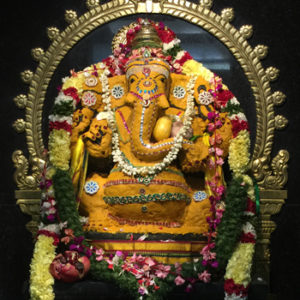 Lord Ganesa, also known as Vinayaka or Pillaiyar in Tamil, is the first son of Lord Siva and He is the first deity worshipped by Hindus in any function or festival at home or a Temple. This altar occupies a prominent position. While at the beginning, the altar was started as an ‘auxiliary’ altar to the Murugan temple, by popular demand and participation by majority of the devotees, this altar also has been recognized as a ‘Moolasthana’ or main altar with its own Flagpole (Kodi Kambam) and Annual Festival (Brahmaotsava). Our Ganesa is named ‘VARASIDDHI VINAYAKAR’ meaning one grants all boons to the devotees. The main festival at this altar is the Annual Festival in May-June, conducted for 15 days, ending on Vaikasi Visakam day.
Lord Ganesa, also known as Vinayaka or Pillaiyar in Tamil, is the first son of Lord Siva and He is the first deity worshipped by Hindus in any function or festival at home or a Temple. This altar occupies a prominent position. While at the beginning, the altar was started as an ‘auxiliary’ altar to the Murugan temple, by popular demand and participation by majority of the devotees, this altar also has been recognized as a ‘Moolasthana’ or main altar with its own Flagpole (Kodi Kambam) and Annual Festival (Brahmaotsava). Our Ganesa is named ‘VARASIDDHI VINAYAKAR’ meaning one grants all boons to the devotees. The main festival at this altar is the Annual Festival in May-June, conducted for 15 days, ending on Vaikasi Visakam day.
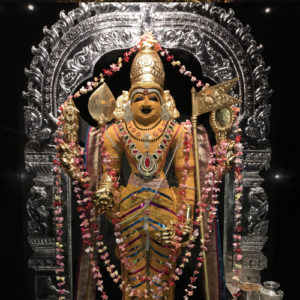
Also known as SUBRAMANYA or KARTHIK, He is installed in one of the ‘moolasthanas’. He is the second son of Lord Siva and is considered the Commander-in-Chief of the divine army. He is the main deity worshipped by the Tamil speaking community all over the world. The ‘Vigraha’ of Murugan is made of blue granite and it so happens that our Murugan is the tallest Murugan vigraha in the world. Toronto Murugan is named ‘SIVASUBRAMANIAN’ based on the unique design of the ‘moorthi’. The Brahmotsava or the Annual Festival for Murugan is celebrated for 15 days ending on Ani Utharam day (June).
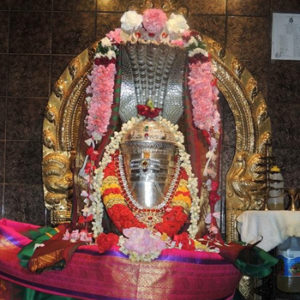 Lord Siva, one of the Hindu Trinity, is worshipped in the form of ‘Linga’ to signify the philosophy of God being ‘Formless’ or beyond any form attributed to Him. Lord Siva occupies a pride of place in Hindu Temples. In this Temple, Lord Murugan established at the moolasthana, Siva and Siva parivar or family, occupy the subsidiary altars by the side of Murugan altar. The ‘Linga’ installed in the Temple has a very inspiring and interesting background. It is not a man-made statue. It was picked up in the holy Ganges waters near Kasi (Banares) by the Paramacharya of Kanchipuram and was kept in his puja altar. He has graciously given this beautiful Linga with golden ‘rekhas’ for our Temple. The moorthi is named as ‘CHANDRAMAULEESWARAR’. Sivarathri (Feb.) is the major Festival celebrated at this altar.
Lord Siva, one of the Hindu Trinity, is worshipped in the form of ‘Linga’ to signify the philosophy of God being ‘Formless’ or beyond any form attributed to Him. Lord Siva occupies a pride of place in Hindu Temples. In this Temple, Lord Murugan established at the moolasthana, Siva and Siva parivar or family, occupy the subsidiary altars by the side of Murugan altar. The ‘Linga’ installed in the Temple has a very inspiring and interesting background. It is not a man-made statue. It was picked up in the holy Ganges waters near Kasi (Banares) by the Paramacharya of Kanchipuram and was kept in his puja altar. He has graciously given this beautiful Linga with golden ‘rekhas’ for our Temple. The moorthi is named as ‘CHANDRAMAULEESWARAR’. Sivarathri (Feb.) is the major Festival celebrated at this altar.
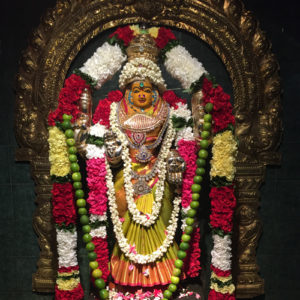 The consort of Lord Siva, Goddess Parvathi, is installed in a beautiful altar to the right of Lord Siva. The vigraha is cute granite one with the divine grace and beauty personified. She is called ‘THIRIPURASUNDARI’ meaning the ‘most beautiful damsel in all the three worlds’. The special festival for this altar is the 21-day Ketharagowri Vratham (Nov.). 5. NATARAJA: Lord Siva is often depicted as ‘Nataraja (king of the Dance)’ in the form of Cosmic Dancer. His dance is providing the life to the universe. Following the traditions of calling Nataraja as golden-bodied (‘Ponnar Meniyan’) dancing in a Golden Sabha (‘Ponnambalam’) with gold plated roof in the most famous Nataraja Temple in Chidambaram, our Nataraja altar is also have extensive gold leaf work on the vimana (roof). The beautiful metallic moorthy and His Consort Sivakami are gold plated and the main vigraha sculptured on the back wall is covered with gold leaf, making this also a Golden Temple. The form of Nataraja is considered to be the masterpiece in iconography. Special festival in this altar is the 10-day Thiruvemba Festival in Dec-Jan.
The consort of Lord Siva, Goddess Parvathi, is installed in a beautiful altar to the right of Lord Siva. The vigraha is cute granite one with the divine grace and beauty personified. She is called ‘THIRIPURASUNDARI’ meaning the ‘most beautiful damsel in all the three worlds’. The special festival for this altar is the 21-day Ketharagowri Vratham (Nov.). 5. NATARAJA: Lord Siva is often depicted as ‘Nataraja (king of the Dance)’ in the form of Cosmic Dancer. His dance is providing the life to the universe. Following the traditions of calling Nataraja as golden-bodied (‘Ponnar Meniyan’) dancing in a Golden Sabha (‘Ponnambalam’) with gold plated roof in the most famous Nataraja Temple in Chidambaram, our Nataraja altar is also have extensive gold leaf work on the vimana (roof). The beautiful metallic moorthy and His Consort Sivakami are gold plated and the main vigraha sculptured on the back wall is covered with gold leaf, making this also a Golden Temple. The form of Nataraja is considered to be the masterpiece in iconography. Special festival in this altar is the 10-day Thiruvemba Festival in Dec-Jan.
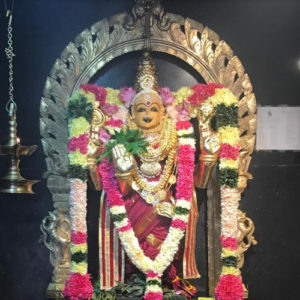 Goddess Durga has a special place in the family of Hindu Pantheon and in this temple she is depicted as ‘MAHISHASURA MARDHINI’ – the victorious virtue over the ‘bull- headed’ ignorance and evil. The vigraha is a very beautiful maiden standing on a buffalo head in the form of ‘Vishnu-Durga’ the most peaceful and gracious form of Durga Devi. Main festival for Durga is the Navarathri Festival in Sept-Oct. of every year.
Goddess Durga has a special place in the family of Hindu Pantheon and in this temple she is depicted as ‘MAHISHASURA MARDHINI’ – the victorious virtue over the ‘bull- headed’ ignorance and evil. The vigraha is a very beautiful maiden standing on a buffalo head in the form of ‘Vishnu-Durga’ the most peaceful and gracious form of Durga Devi. Main festival for Durga is the Navarathri Festival in Sept-Oct. of every year.
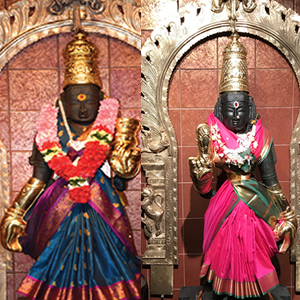 It is an interesting idea that Hindu gods are depicted with two consorts. The male identity symbolizes matter (‘Sivam’) whereas the female identities symbolize ‘Sakthi’ or energy; the two Devis usually signify the ‘Static or Mental’ and ‘Dynamic or Physical’ energies.
It is an interesting idea that Hindu gods are depicted with two consorts. The male identity symbolizes matter (‘Sivam’) whereas the female identities symbolize ‘Sakthi’ or energy; the two Devis usually signify the ‘Static or Mental’ and ‘Dynamic or Physical’ energies.
In North Indian tradition, Murugan is depicted as a confirmed bachelor and Ganesa is depicted with two consorts named ‘Sidhi’ and ‘Budhi’! As per the traditions in South India, Murugan has two consorts named Valli and Devayani. Valli signifies the ‘Earth’ or the ‘Kriya Sakthi’ while Devayani signifies the ‘heavens’ or the ‘lchcha Sakthi’.
At this Temple, Lord Murugan Himself is in a West-facing altar, which is rare by itself. The altars of His Consorts VALLI and DEVAYANI are located across the hall in front of Him, facing Him towards the East. Another unique feature of these two altars in our Temple is their location. In Many temples in India and Sri Lanka, the two devis of Murugan are usually located by His side either in the same altar or in separate altars by the side. Because of the geographical constraints, the Sthapathi has chosen this special but entirely authentic configuration to house the consorts of Lord Murugan.
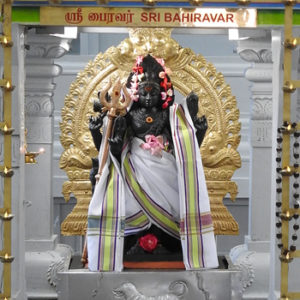 One of the manifestations of Lord Siva is called ‘Bhairav’ and in this form He is the patron deity of Kasi. In Tamil tradition, he is considered the guardian of the village or the Temple and it is a tradition to leave the keys to the temple every night at His feet after closing the Temple and collect them from there for opening the Temple in the morning..
One of the manifestations of Lord Siva is called ‘Bhairav’ and in this form He is the patron deity of Kasi. In Tamil tradition, he is considered the guardian of the village or the Temple and it is a tradition to leave the keys to the temple every night at His feet after closing the Temple and collect them from there for opening the Temple in the morning..
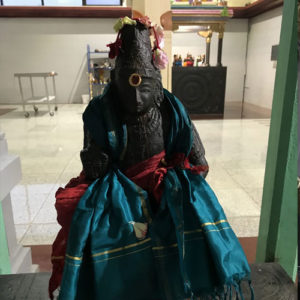 This saint is known for his extreme devotion to Lord Siva who became the Chief of the Siva Ghanas who guard the abode of Siva. There are many beliefs and traditions about rituals at this altar – one is to clap hands in front of the saint without too much noise presumably to attract his attention to mark your attendance; another belief is to show him that your hands are ‘clean’ and you are not taking anything from the Temple!
This saint is known for his extreme devotion to Lord Siva who became the Chief of the Siva Ghanas who guard the abode of Siva. There are many beliefs and traditions about rituals at this altar – one is to clap hands in front of the saint without too much noise presumably to attract his attention to mark your attendance; another belief is to show him that your hands are ‘clean’ and you are not taking anything from the Temple!
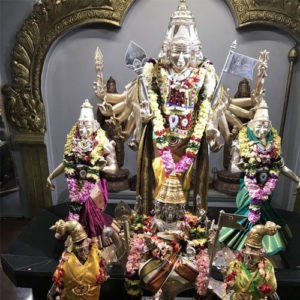 Murugan’s avatar – ‘Arumugaswamy’ – with 6 faces and 12 hands, is considered his Martial form when he fought and defeated the demon Suran. Beautiful and majestic metal statue of Arumugaswami is housed in an artistic altar by the Western Wall of the Temple.
Murugan’s avatar – ‘Arumugaswamy’ – with 6 faces and 12 hands, is considered his Martial form when he fought and defeated the demon Suran. Beautiful and majestic metal statue of Arumugaswami is housed in an artistic altar by the Western Wall of the Temple.
New additions/ modifications to Altars (2012)
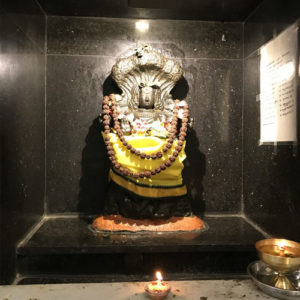 Lord Siva, in the form of ‘Dakshinamoorthy ( South facing Murthi) is considered as the Universal Guru (FIRST TEACHER). He is depicted as an ascetic sitting under a Peepal tree, teaching ‘Gnana’ to a few Rishis sitting in front of Him. The vigraha is usually located on the sides of Siva altar, in a Koshta altar facing south. Also, the statue is on the South face of the Vimana. Though the altar is only an auxiliary altar on the side of the main Siva altar, devotees do pujas to Dakshinamoorthy, especially on Thursdays ( Guruvaram or Teacher’s day). For the benefit of the devotees, this side altar is renovated to a larger and more accessible size where more elaborate pujas can be conducted.
Lord Siva, in the form of ‘Dakshinamoorthy ( South facing Murthi) is considered as the Universal Guru (FIRST TEACHER). He is depicted as an ascetic sitting under a Peepal tree, teaching ‘Gnana’ to a few Rishis sitting in front of Him. The vigraha is usually located on the sides of Siva altar, in a Koshta altar facing south. Also, the statue is on the South face of the Vimana. Though the altar is only an auxiliary altar on the side of the main Siva altar, devotees do pujas to Dakshinamoorthy, especially on Thursdays ( Guruvaram or Teacher’s day). For the benefit of the devotees, this side altar is renovated to a larger and more accessible size where more elaborate pujas can be conducted.
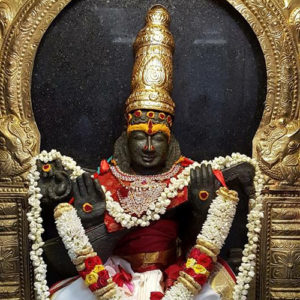 A new altar is created along the western wall for Goddess Saraswathy – who is the Goddess of Knowledge and Arts. She is worshipped especially by all students. Special pujas are done at this altar during Vijayadasami (Sept.-Oct.) day of Navarathri Festival. The children are initiated into learning ( called EDU THODAKKAM or VIDYARAMBAM) by guiding the children to start writing the alphabet in a plate of rice. Of course, there will be a lot of student attendees for puja at the altar during school examination times, praying for high marks and success
A new altar is created along the western wall for Goddess Saraswathy – who is the Goddess of Knowledge and Arts. She is worshipped especially by all students. Special pujas are done at this altar during Vijayadasami (Sept.-Oct.) day of Navarathri Festival. The children are initiated into learning ( called EDU THODAKKAM or VIDYARAMBAM) by guiding the children to start writing the alphabet in a plate of rice. Of course, there will be a lot of student attendees for puja at the altar during school examination times, praying for high marks and success
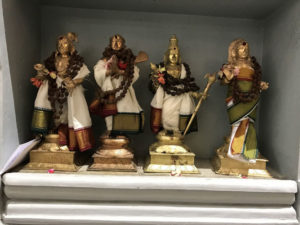 In the Saivite traditions, there are sixty three sages called ‘Nayanmars’ – Ardent devotees of Lord Siva who have attained Sainthood through their intense devotion and charitable activities. Big Siva temples will have a gallery of their statues – either in granite or in metal – located behind the altar of Siva. The most famous festival associated with honoring the Nayanmars is Celebrated in the well-known Kapeeleeswarar Temple in Mylapore, Chennai India. Even though our Temple is quite big, still we could not accommodate altars for all the 63 Nayanmars. A special altar is created in a location between the altars of Parvathi and Natarja, in front of Siva, where the bronze vigrahas of the most popular four Nayanmars – Appar, Sundarar, Manickavasakar and Gnansambandar – are installed and daily pujas offered.
In the Saivite traditions, there are sixty three sages called ‘Nayanmars’ – Ardent devotees of Lord Siva who have attained Sainthood through their intense devotion and charitable activities. Big Siva temples will have a gallery of their statues – either in granite or in metal – located behind the altar of Siva. The most famous festival associated with honoring the Nayanmars is Celebrated in the well-known Kapeeleeswarar Temple in Mylapore, Chennai India. Even though our Temple is quite big, still we could not accommodate altars for all the 63 Nayanmars. A special altar is created in a location between the altars of Parvathi and Natarja, in front of Siva, where the bronze vigrahas of the most popular four Nayanmars – Appar, Sundarar, Manickavasakar and Gnansambandar – are installed and daily pujas offered.
An interesting and inspiring information about the special devotion each of them held for Lord Siva. Each Nayanmar handled his devotion to Lord Siva in an unique way. Ganasambandar’s devotion is that of a child to his parents – the story is when Sambandar was a child of 5 years and when he was hungry and crying for milk, Siva and Parvati appeared from the heavens and Parvathi fed him Milk of knowledge ( Gnana) and he composed his first Thevaram starting with the words ‘Ammayai Appa..’ (meaning Oh Mother, Father). The devotion of Sundarar is that of a very close friend and his relations with Siva was that of a very close friend and he gets the blessings by demanding and going to the extent of taking Siva to task if the blessings are delayed. Appar, also known as Thirunavakkarasu (‘King of tongue’ – for his literary compositions) is a devotee who went through conversion/reconversion amid royal persecution. And his speciality is the absolute confidence in the power of chanting of Siva’s name. The fourth, Manickavasagar was a Minister in the Pandyan Kingdom and his speciality is ‘Steadfast devotion with complete detachment from regular life’.
Deities in the Vishnavite tradition
- Venkateswara
- Mahalakshmi
- Aandaal
- Ram Parivar
- Sudarsana
- Garuda
- Satyanarayana & Santhanagopalan
- Azhwars
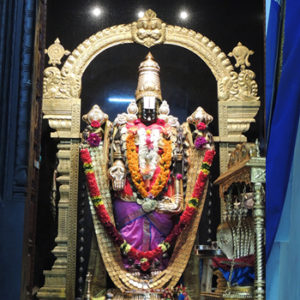 Lord Venkateswara is the most popular form of Vishnu to be worshipped all over the world. In our Temple, He is installed as a very beautiful murthi, standing majestically 8 feet tall, bestowing His divine grace on all the devotees. This altar is also a moolasthanam and as such the Annual Brahmothsava Festival is celebrated with Flag hoisting and Ther (Chariot) festival. This main festival is celebrated for 9 days in Purattasi (Sept.-Oct.). One of the most beautiful services for Sri Venkateswara (Balaji) is the Poolangi Seva, when He is completely covered in colorful flowers.
Lord Venkateswara is the most popular form of Vishnu to be worshipped all over the world. In our Temple, He is installed as a very beautiful murthi, standing majestically 8 feet tall, bestowing His divine grace on all the devotees. This altar is also a moolasthanam and as such the Annual Brahmothsava Festival is celebrated with Flag hoisting and Ther (Chariot) festival. This main festival is celebrated for 9 days in Purattasi (Sept.-Oct.). One of the most beautiful services for Sri Venkateswara (Balaji) is the Poolangi Seva, when He is completely covered in colorful flowers.
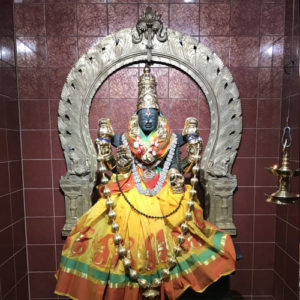 As She is fondly known as ‘THAYAR” meaning MOTHER, Goddess Lakshmi is the Goddess of Wealth and as the divine consort of Lord Vishnu, She is the one who helps us to His grace to have a fully protected and prosperous life on earth and the heavens. Special services like ‘Varalakshmi Puja’, ‘Dhana puja’ at the time of Diwali and the Navarathri are the main festivals at this altar.
As She is fondly known as ‘THAYAR” meaning MOTHER, Goddess Lakshmi is the Goddess of Wealth and as the divine consort of Lord Vishnu, She is the one who helps us to His grace to have a fully protected and prosperous life on earth and the heavens. Special services like ‘Varalakshmi Puja’, ‘Dhana puja’ at the time of Diwali and the Navarathri are the main festivals at this altar.
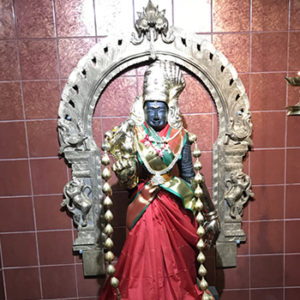 Mother Earth in the form of Bhudevi is considered as the earthly consort of Vishnu and is depicted as ‘Aandaal’ and as an incarnation in Srivilliputtur. The famous Thiruppavai – a collection of 30 beautiful Tamil verses- is composed by her and is usually chanted during the month of Margazhi (Dec.-Jan.) in Vishnavite Temples. The most important festival at this altar is ‘Adi Pooram Day’ in August, considered as her birthday. There are seven moorthis of ‘Sakthi’ or Amman in this Temple, depicting different aspects of Universal Mother and Aandaal Moorthi is one of the most beautiful in style and decoration.
Mother Earth in the form of Bhudevi is considered as the earthly consort of Vishnu and is depicted as ‘Aandaal’ and as an incarnation in Srivilliputtur. The famous Thiruppavai – a collection of 30 beautiful Tamil verses- is composed by her and is usually chanted during the month of Margazhi (Dec.-Jan.) in Vishnavite Temples. The most important festival at this altar is ‘Adi Pooram Day’ in August, considered as her birthday. There are seven moorthis of ‘Sakthi’ or Amman in this Temple, depicting different aspects of Universal Mother and Aandaal Moorthi is one of the most beautiful in style and decoration.
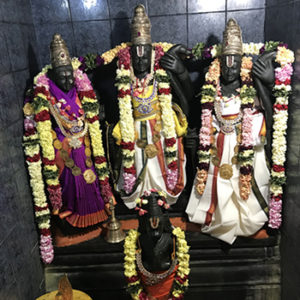 As per the Hindu traditions and later day interpretation of the epics, Lord RAMA is considered as the Sixth incarnation of Vishnu and considered the ideal example for the mankind to follow. The Ram Parivar, meaning Rama’s family- Sri Ram, Sri Lakshman (younger brother), Goddess Sita (Wife) and Sri Hanuman (the most ardent devotee)- is usually worshipped in a separate altar. In the Toronto Temple, Sri Rama altar is in a specially sculpted mandir with its own prakara. The main festival in this altar is the Rama Navami Festival (March-April). During the 2012 Kumbabishekam ceremonies new beautifully sculpted granite statues of Sri RAMA, Sri LAKSHMANA and Goddess SITA are installed in the renovated and remodelled altar.
As per the Hindu traditions and later day interpretation of the epics, Lord RAMA is considered as the Sixth incarnation of Vishnu and considered the ideal example for the mankind to follow. The Ram Parivar, meaning Rama’s family- Sri Ram, Sri Lakshman (younger brother), Goddess Sita (Wife) and Sri Hanuman (the most ardent devotee)- is usually worshipped in a separate altar. In the Toronto Temple, Sri Rama altar is in a specially sculpted mandir with its own prakara. The main festival in this altar is the Rama Navami Festival (March-April). During the 2012 Kumbabishekam ceremonies new beautifully sculpted granite statues of Sri RAMA, Sri LAKSHMANA and Goddess SITA are installed in the renovated and remodelled altar.
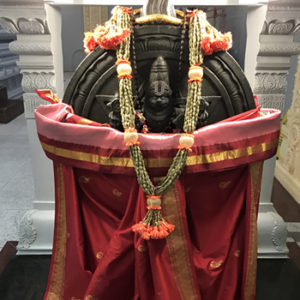
The Wheel in the hands of Vishnu is considered a separate deity named Sudarsana (Chakrathalwar) and is installed and worshipped in a separate altar. One can compare the worship of Sudarsana in a Vishnu Temple to that of the Navagrahas in a Siva Temple. Both the granite and the metallic moorthis of Sri Sudarsana are very intricately and beautifully made and depicted as a Wheel with thousand flames ready to destroy evil and protect the devotees. The special function at this altar is the ‘Sudarsana Homa’ – a homam conducted elaborately to protect the devotees from all evil and bestow a safe and prosperous life.
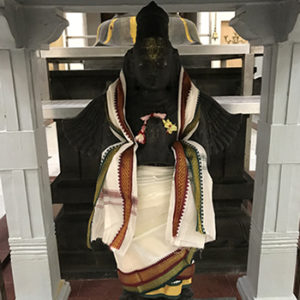
The King of birds – Garuda or Eagle – is usually installed as the vehicle or vahana of Vishnu, in a small altar directly across from Vishnu altar and worshipped regularly.
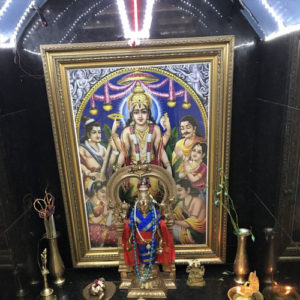 A SPECIAL PUJA CALLED ‘Sri Satyanarayana Puja’ dedicated to the worship of Lord Vishnu in the avatar of Sri Satyanarayana has become a very popular and widely attended in our Temple. A new beautiful bronze statue of Sri Satyanarayana is brought from India and installed in a special altar along the southern wall. The popular puja is done every Full Moon day with a large number of families participating.
A SPECIAL PUJA CALLED ‘Sri Satyanarayana Puja’ dedicated to the worship of Lord Vishnu in the avatar of Sri Satyanarayana has become a very popular and widely attended in our Temple. A new beautiful bronze statue of Sri Satyanarayana is brought from India and installed in a special altar along the southern wall. The popular puja is done every Full Moon day with a large number of families participating.
In the same altar, a new beautiful bronze statue of ‘Santhanagopalan – Infant image of Lord Krishna as the Original Child from whom the Universe is evolved and gets absorbed at the end of ‘pralayams’ (final deluge). It is a belief of the devotees that they will get blessed with children if they do a special puja carrying the Santhanagopalan statue in their lap.
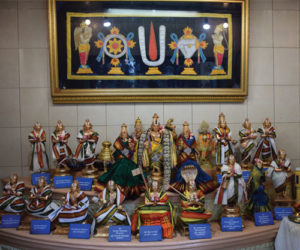
Like the 63 Nayanmars on the Saivite tradition, there are 12 names recognised as the ‘close devotees of Lord Vishnu’ collectively known as ‘Azhwars ‘ including a lady devotee – Aandaal, who composed the Thiruppavai – a Tamil literary classic chanted as prayers at all Vaishnavite homes and temples.
For general use, Vasanthamandapam, Sabha Mandapam (Ezhundharuli Mandapam) and other auxiliary structures have been renewed and painted in multicolor.
In summary, this Temple represents the finest traditions of Hinduism in this far off land, satisfying the religious and spiritual needs of the Hindu community.
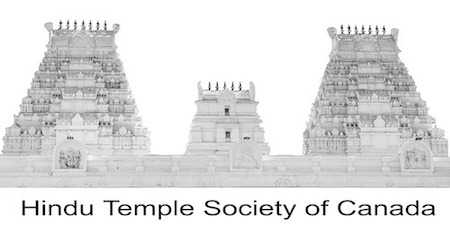
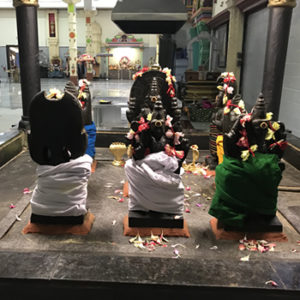 Hindus traditionally believe that the planets- Sun, Moon, Sevvai(Angaraka or Mars), Budh(Mercury), Guru (Viyalan or Jupitor), Sukkiran (Venus), Sani (Saturn) and two other celestial features known as Raghu and Kethu- have considerable influence of the life of mankind and they are worshipped in all Siva Temples. Special puja to Sani, particularly on Saturdays and that too in the month of Purattasi (Sep.-Oct) is done to ward off the ill effects. The altar was reconstructed in 2012 with new murthis (with their Vahanas also incorporated in the carving) and a more ornate altar.
Hindus traditionally believe that the planets- Sun, Moon, Sevvai(Angaraka or Mars), Budh(Mercury), Guru (Viyalan or Jupitor), Sukkiran (Venus), Sani (Saturn) and two other celestial features known as Raghu and Kethu- have considerable influence of the life of mankind and they are worshipped in all Siva Temples. Special puja to Sani, particularly on Saturdays and that too in the month of Purattasi (Sep.-Oct) is done to ward off the ill effects. The altar was reconstructed in 2012 with new murthis (with their Vahanas also incorporated in the carving) and a more ornate altar.